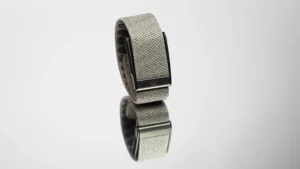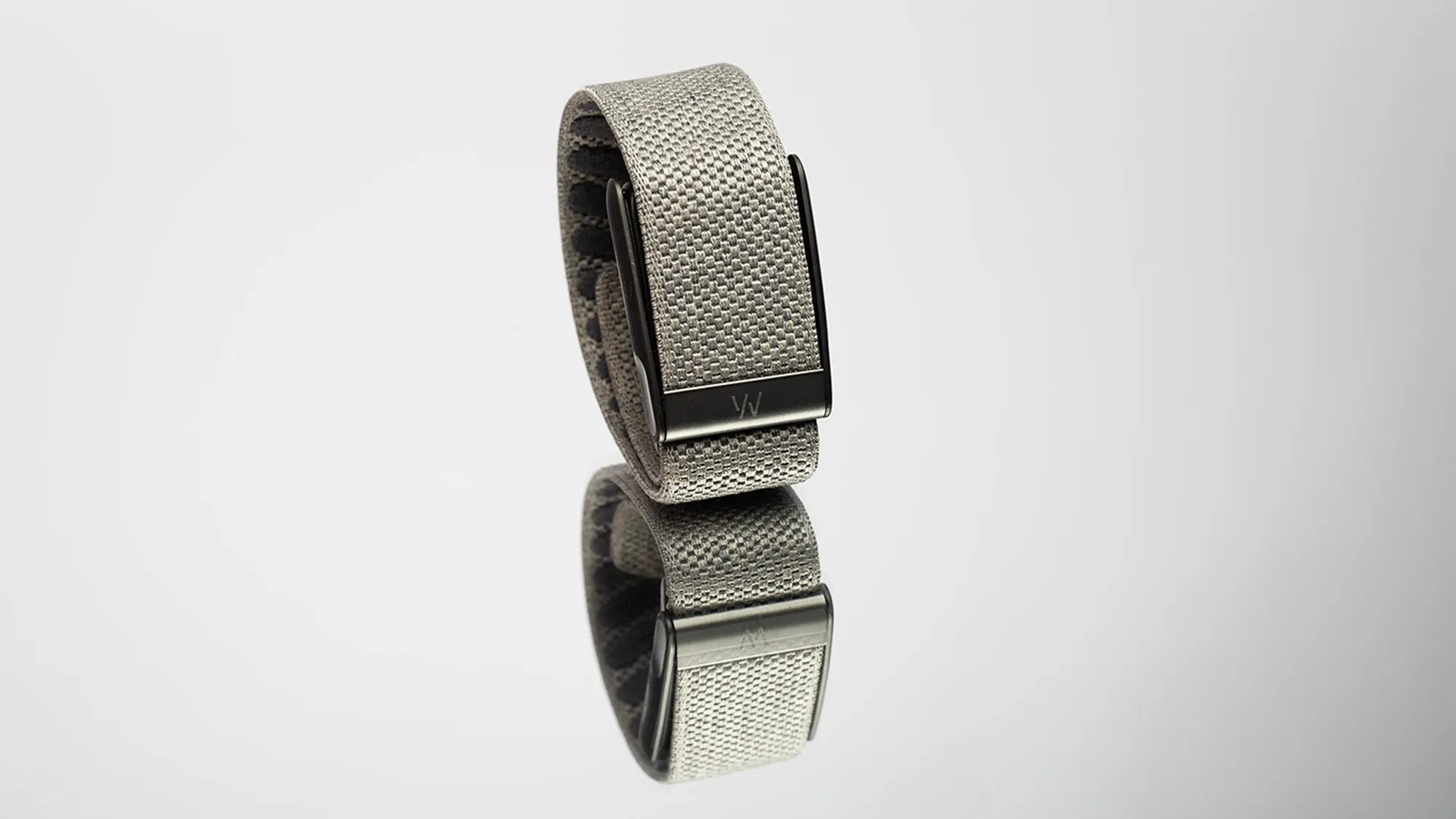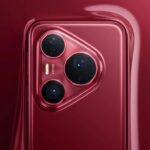Whoop Inc., a company known for its increasingly popular screen-less fitness bands that prioritize data collection and analysis, has debuted updated hardware designed to appeal to a wider audience.

The new devices, the Whoop 5.0 and the Whoop MG (short for Medical Grade), introduce more compact designs, improved battery life, and a range of new health monitoring features, notably including blood pressure tracking and an ECG feature in the higher-end MG model. These updates position Whoop as a strong alternative in the competitive wearable tech market.
Whoop’s Unique Approach: Screen-less Wearable Tech
A defining characteristic of Whoop fitness bands is their deliberate lack of a screen. This is a core philosophical choice by the company aimed at minimizing distractions and encouraging users to focus on the data and insights provided exclusively through the accompanying smartphone app. The screen-less design also contributes to a more compact form factor and significantly enhances battery life compared to many smartwatches.
By not having a display, Whoop also avoids the need to develop and maintain a complex on-device software interface, focusing all its engineering efforts on the data processing and analysis within the app.
Introducing the New Hardware: Whoop 5.0 and Whoop MG
The newly launched Whoop 5.0 and Whoop MG represent Whoop’s first new hardware models in over three and a half years. While their appearance remains understated – comfortable and not drawing much attention, often worn with a simple knit band – the updated hardware features a slimmer design.
They also boast improved battery life, reportedly lasting 14 days on a single charge, a notable increase from the estimated six and a half days for the previous Whoop 4.0. A wireless battery pack is included for users on higher subscription tiers, extending the battery life to around a month on a single charge cycle. The devices are also water-resistant, rated safe for swimming in 10 meters of water for up to two hours, though higher-impact water activities are not recommended.
Core Health and Fitness Metrics Tracked
Both the Whoop 5.0 and Whoop MG are equipped with advanced sensors to track a comprehensive suite of physiological metrics. These include respiratory rate, resting heart rate, skin temperature, blood oxygen levels (SpO2), and heart rate variability (HRV). By continuously collecting this raw biometric data, Whoop provides users with a detailed look at their body’s performance and state of recovery beyond just simple activity counts.
Both models also offer Vo2 max measurement and the ability to estimate a wearer’s physiological age, though the latter is tied to higher subscription plans.
The Whoop Framework: Strain, Recovery, and Sleep
Whoop’s key differentiator lies in its powerful analytical software and the framework it uses to interpret the collected data. The app distills the various biometrics into three headline numbers: Strain Score, Recovery Score, and Sleep Performance Score. The Strain Score quantifies the physiological effort a user takes on throughout the day from workouts and daily activities.
The Recovery Score, calculated from metrics like HRV, resting heart rate, and sleep, assesses the body’s readiness to perform. The Sleep Performance Score measures the quality and duration of a user’s sleep relative to their individual needs. These three figures are intuitively presented as color-coded rings in the app, making it easy for users to understand their daily status at a glance. Based on these calculations, the app provides personalized recommendations for how hard the user should push themselves on any given day.
Enhanced Sleep Tracking and Women’s Health
The new Whoop models come with improvements to sleep tracking, a core feature for the company. The topline Sleep Score is now based on four key factors: the amount of sleep obtained compared to the user’s calculated need, the consistency of sleep timing from night to night, overall “sleep efficiency” (time actually spent asleep in bed), and the amount of “high sleep stress” accrued.
As with previous versions, the feature also accurately detects and reports the time spent in different stages of the sleep cycle (light, deep, REM). Additionally, the new devices arrive alongside a suite of enhanced women’s health features. These insights into women’s hormone cycles and potential impacts on performance are aimed at appealing to a broader and more diverse demographic, including pregnant, menstruating, and menopausal users, expanding the platform’s relevance beyond its traditional male-dominated elite athlete base.
Advanced Medical-Grade Features (Whoop MG)
The Whoop MG model lives up to its “Medical Grade” moniker by introducing several advanced health monitoring features typically found in higher-end or specialized medical devices. This includes blood pressure tracking, which requires an initial calibration using a standard, medical-style cuff where three manual readings are entered into the app. After calibration, the device can automatically provide daily blood pressure readings.
The Whoop MG also features an ECG feature (electrocardiogram), enabling users to manually initiate a 30-second scan by pinching indentations on the device with their free hand. This ECG capability supports the detection of atrial fibrillation and provides notifications for irregular heart rhythms, aligning with features seen on other wrist-worn devices like the Apple Watch.
The Whoop Age System
Both new Whoop models introduce a physiological age estimate system called Whoop Age. This feature attempts to estimate a user’s “body age” based on nine factors, including sleep consistency, strain levels, VO2 max, and lean body mass. It requires about three weeks of data collection before it can be “unlocked” and provide an initial assessment.
While the concept of a physiological age is different from chronological age and intended to be motivational, allowing users to see how improvements in their fitness and habits can potentially result in a lower “Whoop Age,” the feature adds another layer of personalized insight to the platform.
The Subscription Model and Pricing Structure
Whoop employs a subscription-based business model, which is a key aspect that differentiates it from devices with a one-time purchase price. Access to the platform’s data analysis and insights requires an annual subscription starting at $199 per year, following a one-month free trial. While there is no base fee for the hardware unit itself with a subscription, additional bands cost extra, ranging from $49 to $199 depending on the material.
Access to certain advanced features is tied to higher-tier plans: the $239 “Peak” plan adds the physiological age estimate, and the $359 “Life” plan for the Whoop MG includes access to the advanced blood pressure tracking and ECG feature. Notably, the Whoop hardware becomes useless if the subscription is canceled, and new hardware is not automatically provided free of charge with continued subscription; upgrades to new devices usually require an additional fee (starting at $49).
Navigating the Competitive Landscape
Whoop operates in a crowded and competitive market for wearable tech and fitness trackers. It is pitched as an alternative to smartwatches from companies like Apple and Garmin, which offer features like full color screens, phone notifications, and a wider app ecosystem but typically have much shorter battery lives. Whoop also competes with a new crop of other screen-less trackers like the Oura Ring and Samsung Ring, which also focus on sleep and recovery.
Furthermore, a vast array of fitness and health tracking apps offer some of the same features as Whoop through various devices. Whoop’s challenge is convincing potential customers that its deep, continuous data analysis and subscription model offer unique value that surpasses this competitive landscape.
Business Strategy and Growth Trajectory
Founded in 2012, Whoop initially focused on providing detailed data and analysis to elite athletes, attracting investments from sports stars like Kevin Durant, Eli Manning, and Patrick Mahomes. The company was last valued at $3.6 billion in 2021 after a $200 million funding round led by SoftBank.
More recently, Whoop has seen significant growth in its subscriber base, reporting a 70% increase in members last year, according to CEO Will Ahmed. This growth trajectory, along with the push to broaden its market appeal with features like women’s health insights and marketing materials aimed at casual users, is seen as a prelude to a potential public listing in the future, though no specific timeline has been provided.
Hardware Quirks and Charging Challenges
Despite the comfort and improved battery life, the new Whoop hardware isn’t without its potential frustrations. The reviewer noted that the hardware can be difficult, even “infuriating,” to assemble and put on, a critique also leveled at previous versions. The company even maintains a how-to video, indicating this is a recognized issue.
Another potential drawback is the charging speed. Recharging the battery is relatively slow, reportedly taking around two and a half hours with the wired charger and just under two hours with the wireless module. This contrasts with devices like the Apple Watch or Garmin Forerunner, which can often gain a significant charge in a much shorter time. For optimal use, charging the Whoop overnight or during a nap is recommended.
The Software’s Strength and Tone
Where Whoop truly distinguishes itself is with its accompanying iOS and Android app. Beyond just displaying raw data, the app excels at processing complex biometrics to calculate the key Strain, Recovery, and Sleep scores and provide personalized insights. The app is noted for its ability to distill a lot of data into easily understandable figures presented as color-coded rings.
It also succeeds in striking a non-scolding tone, which the reviewer appreciated, particularly when not hitting sleep goals or strain targets. The app also thoughtfully de-emphasizes metrics like weight and BMI, which some health experts consider flawed. This smart, useful, and less judgey software experience is highlighted as one of Whoop’s strongest assets.
A Powerful, Niche Fitness Tracker Evolves
The launch of the Whoop 5.0 and Whoop MG represents a significant evolution for Whoop’s wearable tech. The updated hardware provides a slimmer design and improved battery life, while the addition of advanced health monitoring features like blood pressure tracking and the ECG feature in the Whoop MG, alongside enhanced sleep tracking and women’s health insights in both models, broadens the platform’s appeal well beyond its original niche of elite athletes.
While the screen-less, subscription-based model and some remaining hardware quirks like difficult assembly and slow charging present challenges in a crowded market, the depth of data analysis, the intuitive Strain-Recovery-Sleep framework, and the insightful, non-judgey software remain Whoop’s core differentiators.
These updates position Whoop as a powerful, specialized fitness tracker alternative aiming to capture a larger share of the consumer wearable tech market by offering comprehensive health monitoring and insights.






